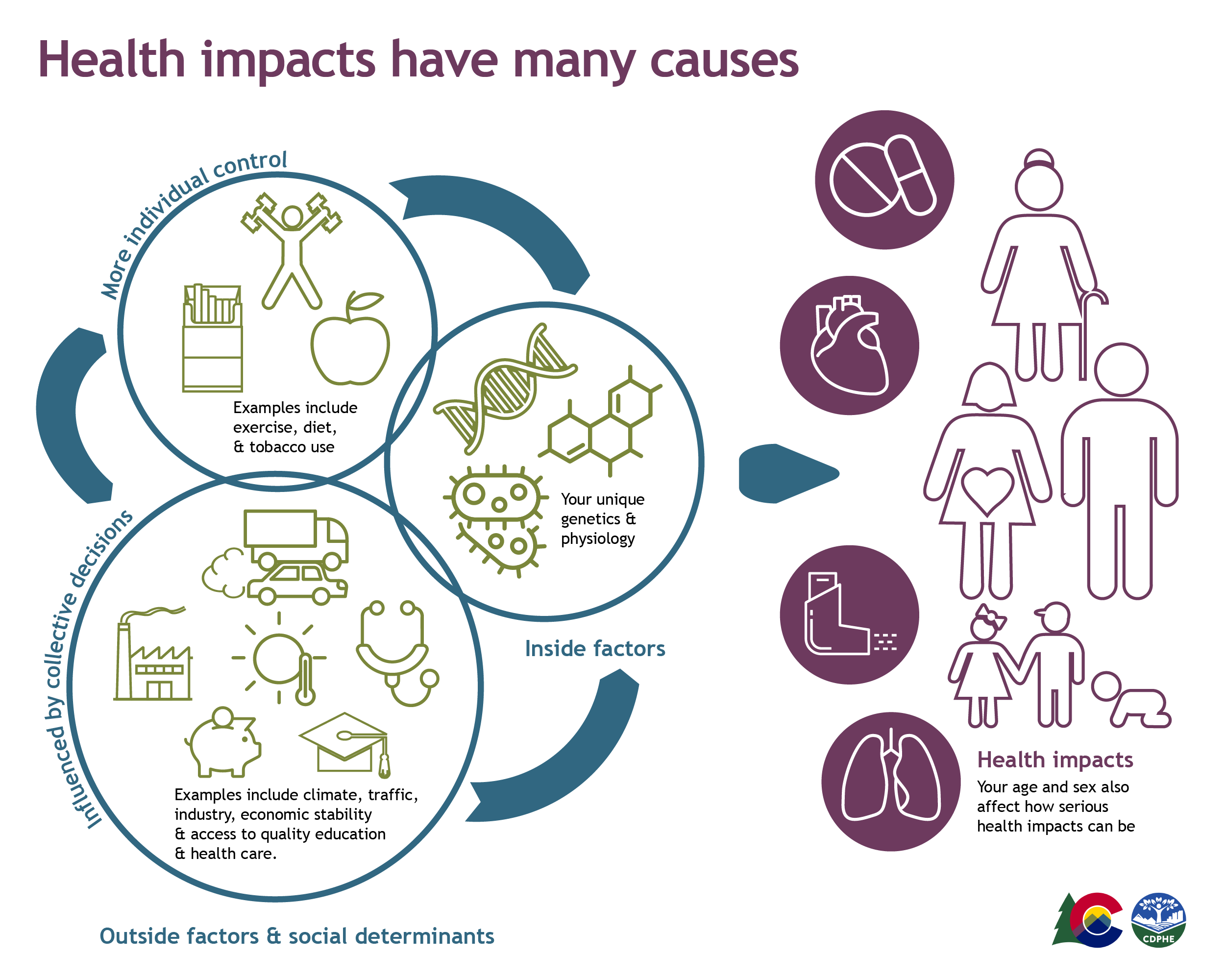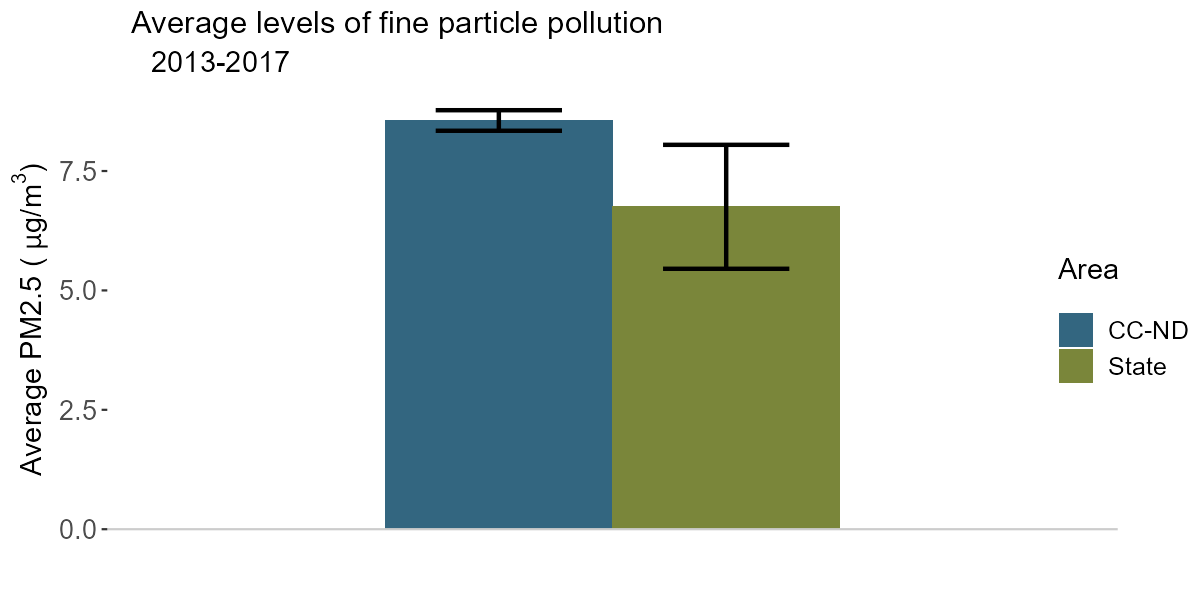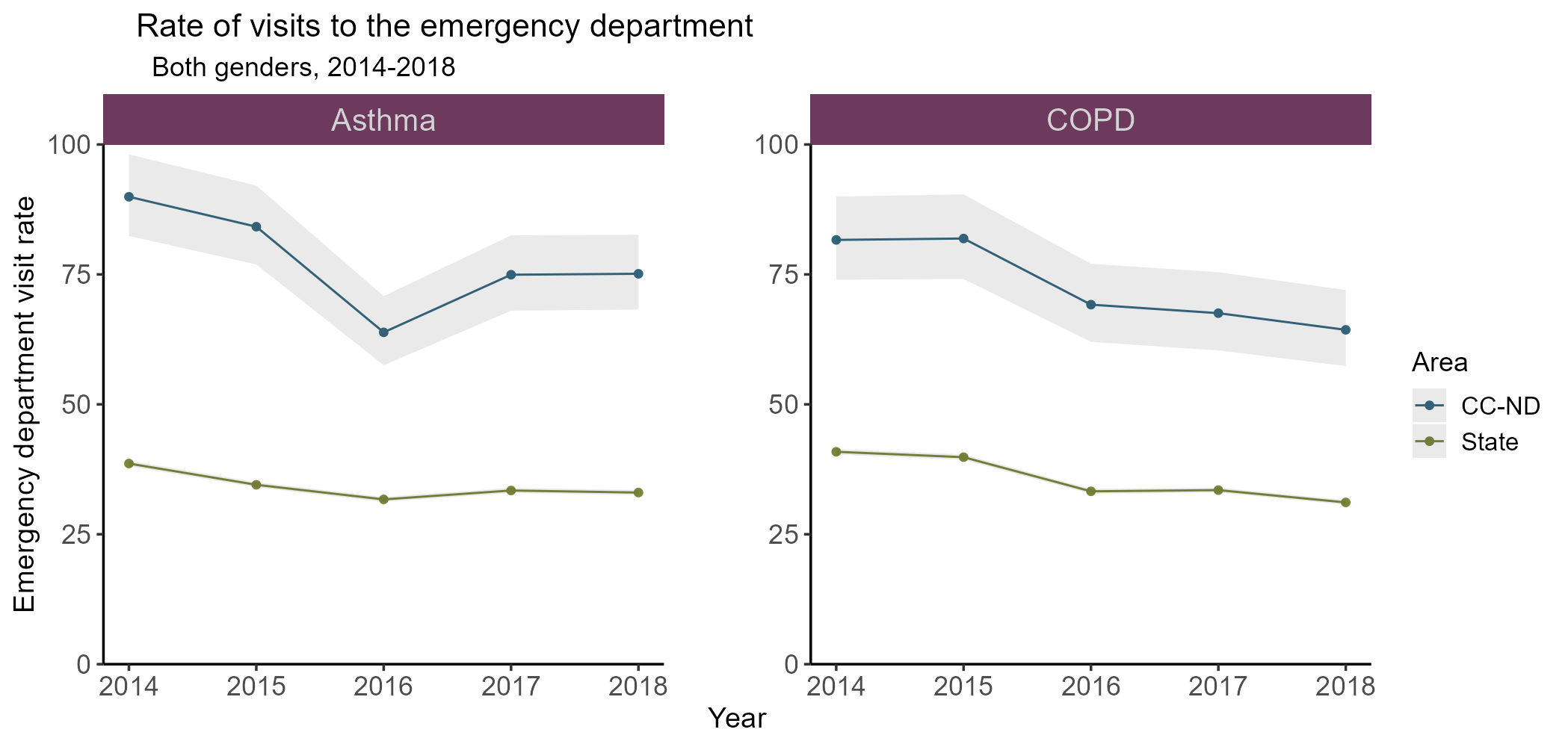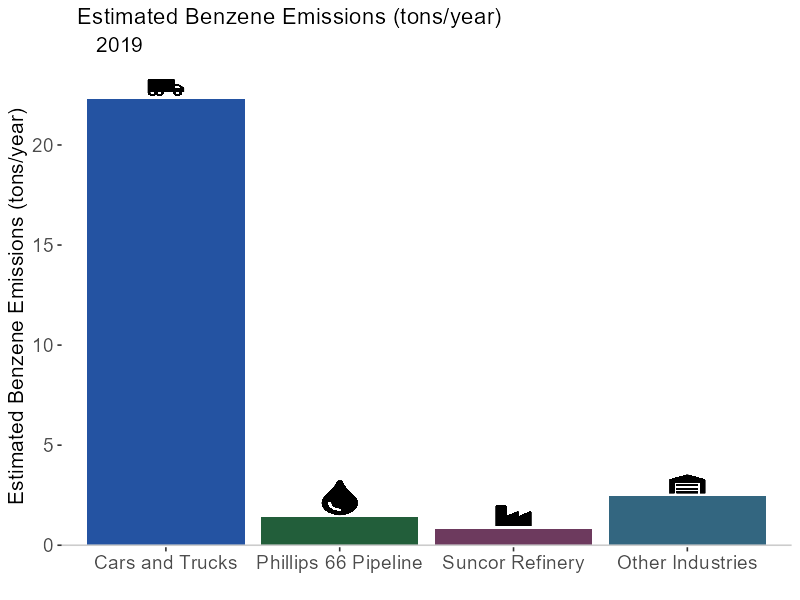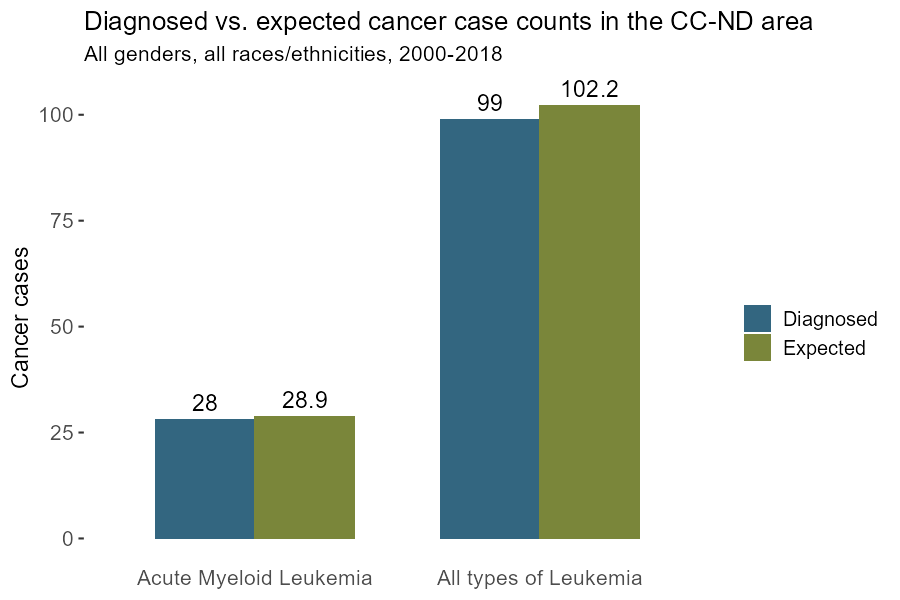Community health & the environment in Commerce City-North Denver
Seleccione para lea esta página en español
Select the underlined text below to jump to that section on the Commerce City-North Denver page.
Introduction | How the environment can impact your health | Regulating pollution and its sources | Pollutants and your health | Take action

Key takeaways
The environment is one of many factors that can impact your health.
There are three things to know about the Commerce City - North Denver (CC-ND) community’s top environmental concerns.
- This area has higher fine particle pollution and more serious respiratory problems than the rest of the state.
- The levels of benzene and hydrogen cyanide that have been measured in the air are not expected to cause harmful health impacts.
- Children in this area are at high risk for lead poisoning. Over time, the percentage of children with elevated blood lead levels has gone down. Prevention and continued lead testing will build on this success.
There are some things in your environment you can’t control. However, you can take action to improve health outcomes for yourself, your family and your community. One of the most important things you can do is get involved in decision-making in your community.
Commerce City-North Denver is home to more than 56,000 people, including about 5,000 children younger than 6 years.
This area is home to many people of color - 60% of people here identify as Latino/a/x and 10% as Black. Compared to Colorado as a whole, people in this area are twice as likely to have lower incomes. About half of all households in this area own the home they live in. In addition, more than 40% of the residents in this area are either multilingual or speak a language other than English. The most common jobs in this area are construction, education, health, and retail.
Several major industries and highways in these neighborhoods contribute to the current pollution burden. Additionally, places like the Rocky Mountain Arsenal and former smelting plants are historic sources of pollution. These and other sites have participated in federal programs aimed at reducing exposure to pollution.
We continue to attend community meetings to listen to people’s concerns about how their environment might impact their health. During listening sessions in 2020 and 2021, we learned about the top concerns and have gathered information about them here.
We understand that questions remain. We are committed to listening to community voices through every possible channel and making meaningful changes based on community input. As an important step forward, we have started working with advisors from the area. This gives us the ability to hear directly from community leaders about environmental health priorities.
Everything in your environment can impact your health. This includes the food you eat, the air you breathe, the water you drink, and the chemicals all around you.
Knowing there is pollution in your environment can be stressful, but not all pollutants will effect your health. For a substance to affect you, you have to breathe it, touch it, or swallow it. Whether something will cause a harmful health impact depends on:
- What it is.
- How much of it you come into contact with.
- How long you are in contact with it.
- How often you come into contact with it.
- Whether you breathed it, touched it, or swallowed it.
- Factors like your age and genetics.
For example, spending a little time with the sunlight touching your skin can be good. Sunshine helps your body make Vitamin D and improves your mood. But spending hours every day in the sun without protecting yourself can hurt you right away by causing sunburn. It can also hurt you later on by causing skin cancer.
Sometimes, exposure to a single substance can cause great harm. More often, though, whether you have harmful health impacts depends on many factors both inside and outside your body. Those things, and your genetics, can combine to cause illness. Often, it is impossible to pinpoint one specific source of a health impact.
You can better control some of the things that cause health impacts more directly. For example, we each can make individual choices about what we eat and how much we exercise. But we also can work together as individuals to collectively influence how much pollution is in our environment. Environmental justice refers to the meaningful involvement of all people in decisions about the environment. CDPHE is committed to partnering with Commerce City - North Denver communities to reduce pollution disparities that can impact your health.

There are many federal and state laws and regulations related to pollution in our environment.
Regulations are mandatory requirements. They can apply to businesses, state or local governments, non-profit institutions, and individuals.
Some laws set the standard for the levels of pollutants allowed in the air, water, or soil. For example:
- National Ambient Air Quality Standards (NAAQS) set the levels of six air pollutants, including fine particles and ozone. These can be harmful to public health and the environment.
- National Primary Drinking Water Regulations set the limits for specific contaminants in drinking water from public water suppliers.
- CDPHE uses the US EPA’s Regional Screening Levels as the starting point for assessing the potential for remediation of contaminated air, water, or soils.
When a company releases pollution above the standard level, it can increase the risk of harmful health impacts. Whether someone will experience harmful health impacts depends on many factors, such as how long someone is exposed.
Other laws and regulations target how pollutants get into our environment by setting limits on the sources of pollution. For example:
- Using authority from the Clean Air Act, we issue permits for air pollution sources that exceed specific thresholds. These permits document allowable emission limits, compliance and control measures.
- Before an industry can put used water into a river or lake, they must get a permit from us. The permit typically requires regular testing for pollutants.
- Facilities that treat, store, or dispose of hazardous waste must follow CDPHE requirements and obtain a hazardous waste permit. These permits help us keep track of the location and amount of hazardous waste being managed. More important, permits ensure facilities are following the laws about design and operation, safety standards, monitoring, and reporting. Permits also require facilities to develop emergency plans, properly train employees to handle hazardous waste, and more.
Sometimes a company violates a regulation or a permit by releasing more pollution than it is allowed to release. We take these violations seriously. The company may have to pay fines for violations, and sometimes might instead fund Supplemental Environmental Projects to benefit communities.
When companies violate regulations or permits, our team investigates the issue to make sure it doesn't happen again. While not every violation affects public health, we are committed to taking action to address pollution that can threaten you.
Not all pollutants are regulated. Agencies review new information on pollutants to determine if they should be included in existing or new regulations.
From talking with the community, we know that air pollution, lead, benzene, and hydrogen cyanide are top concerns.
We know different pollutants are associated with different health problems. We can look at the levels of pollutants and the diseases they are associated with in your community.
Fine particle air pollution
Where fine particle air pollution comes from
Fine particle pollution means particles smaller than 2.5 micrometers. It is also called PM2.5. Fine particle air pollution comes from many different sources.
- Some particles go directly into the air. These can come from factories burning fossil fuels, construction activities, wood-burning fires, and vehicle exhaust.
- Other particles are formed after gases in the air mix together. These gases can come from the whole region and include sulfur oxides, nitrogen oxides, volatile organic compounds, and ammonia.
- Industrial activities, including Suncor, are the largest sources of fine particle pollution in Commerce City - North Denver.
Commerce City - North Denver has higher than average levels of fine particle pollution in the air.
Health impacts of fine particle air pollution
Fine particles can travel deep into the lungs and enter the bloodstream. These particles can cause numerous health impacts, including trouble breathing, asthma attacks, and heart issues.
People in Commerce City - North Denver have more serious breathing problems than the rest of the state.
- These problems include asthma and chronic obstructive pulmonary disease (COPD).
- Adults in the Commerce City-North Denver area have similar asthma levels to adults in other parts of the state. But, Commerce City-North Denver residents go to emergency departments for asthma much more often. Higher levels of air pollution could be one reason why. Additionally, there may be differences in residents’ asthma severity or they may have less access to routine health care.
Benzene
Where benzene comes from
Benzene is one of many volatile organic compounds (also called VOCs) people can be exposed to every day. Outdoor air contains benzene. Low levels come from cigarette smoke, vehicle exhaust, and industrial releases. Higher levels of benzene are found at industrial sites, oil and gas operations, gas stations, and near buses and large trucks.
- We estimated the most important sources of benzene based on information from air permits for industrial sources and data about how much traffic moves through the area.
- CDPHE measured levels of benzene in the area during the summer of 2021. You can see that data here. The levels of benzene we found are not expected to harm people's health.
Health impacts of benzene
- Benzene exposure over long periods can cause anemia and leukemia.
- Short exposures to higher benzene levels can lead to headaches, dizziness, breathing issues, irritated skin, and irritated eyes.
Leukemia cases are not higher than would be expected in Commerce City - North Denver.
Hydrogen cyanide
Where hydrogen cyanide comes from
Hydrogen cyanide is a colorless gas. Human activities cause most of the cyanide in the environment. Sources of hydrogen cyanide include oil refineries, such as Suncor, vehicles, and cigarette smoke.
Health impacts of hydrogen cyanide
- Breathing in high levels of hydrogen cyanide for long periods of time can harm health. It can cause:
- Breathing difficulties.
- Chest pain.
- Vomiting.
- And more.
- Breathing in very high levels for short periods can harm the brain and heart and can cause coma and death.
Hydrogen cyanide levels in Commerce City - North Denver are not expected to harm people's health.
- We have collected air samples and used computer models to figure out how much hydrogen cyanide is in the air in this area. The levels we have seen are not expected to harm people's health.
- We will keep gathering air samples air around Suncor and will continue to evaluate this concern.
- Under a new state law, Suncor must install fenceline monitors to measure hydrogen cyanide and benzene levels by January 2023. The results of those monitors will be reported in real-time to the public. Community members will have an opportunity to provide input on Suncor's community monitoring plan during 2022.
Lead
Where lead comes from
Lead is a type of metal that is found naturally on Earth. Historical smelting plants - Asarco, Omaha & Grant, and Argo - operated in the CC-ND area beginning in the 1870s. As a result, there were elevated levels of lead and arsenic in nearby soils. The area became the Vasquez Boulevard & Interstate 70 (VB/I-70) Superfund site and the Asarco Globe cleanup site.
CDPHE and EPA partnered with community members to clean up lead and arsenic in the soil in north Denver neighborhoods. The cleanup lasted many years and included replacing soil in yards where there were elevated lead levels. In 2014, CDPHE and its partners completed the Asarco globe cleanup. In 2019, the EPA and CDPHE determined that residential soil cleanup was completed at the VB/I-70 Superfund site.
There are still sources of lead in the area, such as lead-based paint in older homes.
Health impacts of lead
Lead exposure is especially harmful for young children. It can damage the brain, slow growth and development, and contribute to learning problems. These problems can last a lifetime.
Before 2014, children in Commerce City - North Denver had more lead poisoning compared to other children in Colorado. High levels of testing in this area have helped identify and prevent more lead poisoning.
Because children in this area are at high risk for lead poisoning, high levels of testing must continue.
- Find out more about the data behind this project on our Commerce City - North Denver data dashboard.
- Test your home for lead in paint or soil, and find out whether your children should get tested. Learn how at colorado.gov/lead/lead-testing.
- If you don’t have a health care provider, find one near you. Community health centers don’t turn people away because of their age, their ability to pay, or whether or not they have health insurance.
- Get involved in community environmental projects. Visit our Commerce City - North Denver web page to find out how.
- Learn about:
Send us feedback on this project. We want to hear from you!

